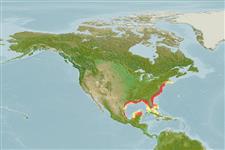>
Eupercaria/misc (Various families in series Eupercaria) >
Sciaenidae (Drums or croakers)
Etymology: Leiostomus: Greek, leios = smooth + Greek,stoma = mouth (Ref. 45335).
More on author: Lacepède.
Environment: milieu / climate zone / depth range / distribution range
Οικολογία
Θαλασσινό(ά); Υφάλμυρο βενθικό(ς); ωκεανόδρομο(ς) (Ref. 51243); εύρος βάθους ? - 60 m (Ref. 10325). Subtropical; 43°N - 19°N
Western Atlantic: Massachusetts to northern Mexico; absent in southern Florida.
Μέγεθος / Βάρος / Age
Maturity: Lm ? range ? - ? cm
Max length : 36.0 cm TL αρσενικό/απροσδιόριστο; (Ref. 7251); common length : 25.0 cm TL αρσενικό/απροσδιόριστο; (Ref. 3702); μεγ. δημοσιευμένο βάρος: 450.00 g (Ref. 40637); μεγ. αναφερόμενη ηλικία: 4 έτη (Ref. 12193)
Found usually over sandy or muddy bottoms in coastal waters to about 60 m depth. Occurs in nursery and feeding grounds in river estuaries during summer and fall. Juveniles often stay in the estuarine waters throughout the year. Feeds mainly on worms, small crustaceans and organic detritus. A small specimen of this species was caught in Tokyo Bay, Japan, probably brought in with the ballast water of a ship (Ref. 10325).
Life cycle and mating behavior
Γεννητική Ωρίμανση | Αναπαραγωγή | Γεννοβολία | Αβγά | Γονιμότητα | Προνύμφες
Robins, C.R. and G.C. Ray, 1986. A field guide to Atlantic coast fishes of North America. Houghton Mifflin Company, Boston, U.S.A. 354 p. (Ref. 7251)
IUCN Red List Status (Ref. 130435)
Threat to humans
Harmless
Human uses
αλιεία: Εμπορικό(ά); δόλωμα: occasionally
Εργαλεία
Special reports
Download XML
Διαδικτυακές πηγές
Estimates based on models
Preferred temperature (Ref.
123201): 13.2 - 26.7, mean 24 °C (based on 314 cells).
Phylogenetic diversity index (Ref.
82804): PD
50 = 1.0000 [Uniqueness, from 0.5 = low to 2.0 = high].
Bayesian length-weight: a=0.00912 (0.00583 - 0.01426), b=3.10 (2.97 - 3.23), in cm total length, based on LWR estimates for this species & (Sub)family-body (Ref.
93245).
Τροφικό Επίπεδο (Ref.
69278): 3.2 ±0.1 se; based on diet studies.
Generation time: 2.6 ( na - na) years. Estimated as median ln(3)/K based on 2
growth studies.
Ελαστικότητα (Ref.
120179): Υψηλό, ελάχιστος χρόνος για διπλασιασμό πληθυσμού < 15 μήνες (K=0.4; tmax=4).
Fishing Vulnerability (Ref.
59153): Low to moderate vulnerability (29 of 100).
Climate Vulnerability (Ref.
125649): Moderate to high vulnerability (47 of 100).
Nutrients (Ref.
124155): Calcium = 101 [57, 196] mg/100g; Iron = 1.09 [0.59, 1.91] mg/100g; Protein = 19.6 [18.6, 20.7] %; Omega3 = 0.351 [0.207, 0.560] g/100g; Selenium = 23.2 [12.9, 43.0] μg/100g; VitaminA = 11.7 [4.5, 36.0] μg/100g; Zinc = 0.981 [0.723, 1.462] mg/100g (wet weight);
